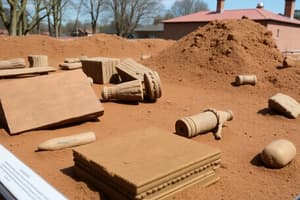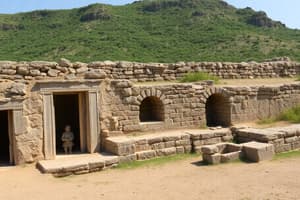Podcast
Questions and Answers
What primary factor enabled the exceptional preservation of the fruit found at Mount Vernon?
What primary factor enabled the exceptional preservation of the fruit found at Mount Vernon?
- The tart variety of cherries used, whose high acidity acted as a natural preservative. (correct)
- The consistently cool and dry atmosphere within the carefully sealed storage pits.
- The fruit's inherent resistance to decay due to its genetic makeup.
- The advanced preservation techniques employed by 18th-century English glassmakers.
The article suggests the fruit bottles were likely forgotten due to which key historical event?
The article suggests the fruit bottles were likely forgotten due to which key historical event?
- George Washington's relocation to Philadelphia to attend to the First Continental Congress
- The great fire that damaged parts of Mount Vernon in the 1760s.
- George Washington's departure to command the Continental Army in 1775. (correct)
- Mount Vernon's temporary conversion into a military hospital during the French and Indian War.
Beyond their historical significance, what potential scientific value do the preserved fruits hold regarding climate studies?
Beyond their historical significance, what potential scientific value do the preserved fruits hold regarding climate studies?
- DNA analysis can reveal how fruit species have adapted to environmental changes in Virginia. (correct)
- The presence of specific pollutants within the fruit can offer insights into air quality during the 1700s.
- Their chemical composition can be compared to modern fertilizers, revealing changes in agricultural practices.
- Isotopic analysis of the fruit's organic matter can provide a direct measure of 18th-century rainfall patterns.
What does the article imply about the social context of the preserved fruits at Mount Vernon?
What does the article imply about the social context of the preserved fruits at Mount Vernon?
If scientists successfully germinate the preserved cherry seeds, what unique historical artifact would result?
If scientists successfully germinate the preserved cherry seeds, what unique historical artifact would result?
What is the most likely reason the article mentions the bottles were made in England?
What is the most likely reason the article mentions the bottles were made in England?
Assuming analysis reveals the preserved cherries are genetically distinct from modern varieties, what could this suggest about agricultural practices since the 18th century?
Assuming analysis reveals the preserved cherries are genetically distinct from modern varieties, what could this suggest about agricultural practices since the 18th century?
What is the primary purpose of the $40 million revitalization project at Mount Vernon, according to the article?
What is the primary purpose of the $40 million revitalization project at Mount Vernon, according to the article?
Flashcards
Mount Vernon Fruit Find
Mount Vernon Fruit Find
Glass bottles containing preserved cherries and berries, dating back to the 18th century, found at George Washington's Mount Vernon home.
Mount Vernon Revitalization Project
Mount Vernon Revitalization Project
The project dedicated to preserving George Washington's historic Virginia mansion for future generations.
Jason Boroughs
Jason Boroughs
The archaeologist who described the discovery of the preserved fruit as "pretty spectacular."
Origin of Bottles
Origin of Bottles
Signup and view all the flashcards
Washington's Departure
Washington's Departure
Signup and view all the flashcards
Intended Use of Fruit
Intended Use of Fruit
Signup and view all the flashcards
Analysis Location
Analysis Location
Signup and view all the flashcards
Germinated Seeds
Germinated Seeds
Signup and view all the flashcards
Study Notes
- Thirty-five 18th-century glass bottles were unearthed at George Washington's Mount Vernon home.
- The bottles were discovered during the excavation of six storage pits in the cellar.
- The excavation is part of a $40 million revitalization project.
- Twenty-nine of the bottles were intact, and contained well-preserved cherries and berries.
- The berries are thought to be gooseberries or currants.
- Principal archaeologist Jason Boroughs described the discovery of fresh fruit after 250 years as "pretty spectacular".
- The bottles were made in England in the mid-1700s.
- They were likely buried before 1776.
- The bottles may have been forgotten after George Washington left the mansion in 1775 to command the Continental Army.
- The artifacts provide a rare glimpse into the daily life and culinary practices of the Washingtons.
- The preserved fruits were sent to the US Department of Agriculture for analysis.
- Initial reports suggest the cherries were likely a tart variety, which may have aided in their preservation.
- The team plans to extract DNA from the cherries and compare it to existing varieties to identify the exact species.
- Scientists also intend to investigate if they can germinate any of the preserved cherry seeds.
Studying That Suits You
Use AI to generate personalized quizzes and flashcards to suit your learning preferences.
Description
Thirty-five 18th-century glass bottles were unearthed at George Washington's Mount Vernon. Twenty-nine of the bottles were intact, containing well-preserved cherries and berries. The bottles, made in England, offer a rare glimpse into the Washingtons' daily life and culinary practices.





